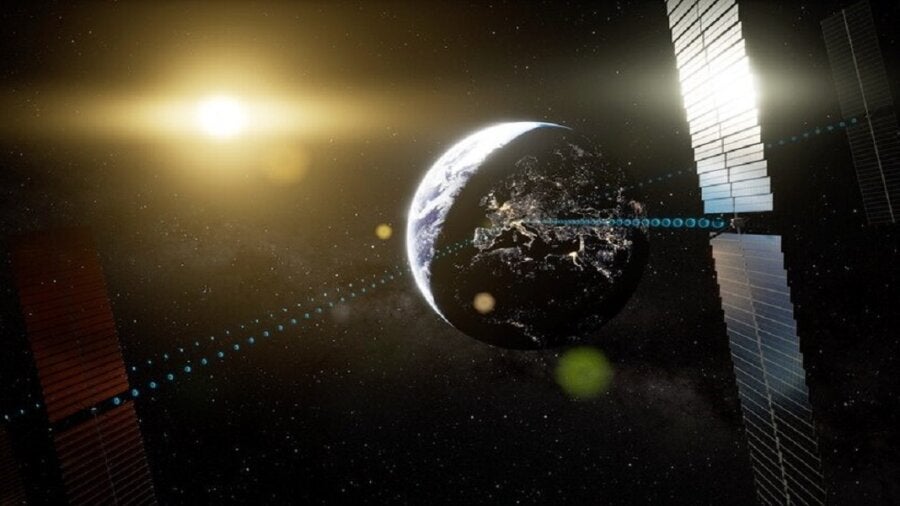
Proposals for beaming solar power down from space have been around since the 1970s, but the idea has long been seen as little more than science fiction. Now, though, Europe seems to be getting serious about making it a reality.
Space-based solar power (SBSP) involves building massive arrays of solar panels in orbit to collect sunlight and then beaming the collected energy back down to Earth via microwaves or high-powered lasers. The approach has several advantages over terrestrial solar power, including the absence of night and inclement weather and the lack of an atmosphere to attenuate the light from the sun.
But the engineering challenge involved in building such large structures in space, and the complexities of the technologies involved, have meant the idea has remained on the drawing board so far. The director general of the European Space Agency, Josef Aschbacher, wants to change that.
A long-time advocate of the technology, Aschbacher recently announced plans for a new research and development program called Solaris, which will lay the groundwork for a full-scale rollout of the technology later this century. The proposal will be put to the ESA Council, which makes funding decisions for the agency, at a meeting in November.
“Space-based solar power would be an important step towards carbon neutrality and energy independence for Europe,” he tweeted. “We have the main building blocks already, but let me be clear: for the project to succeed, much technology development and funding is still needed.”
The move follows the release of two reports commissioned by the agency to assess the feasibility of SBSP by UK-based consultancy Frazer-Nash and Germany-based Roland Berger. Both concluded that the technology could compete with other forms of electricity on price by the middle of this century, but some of the numbers are eye-opening.
The Frazer-Nash report estimated that the research and development investment required to simply get to a prototype SBSP satellite could run to €15.8 billion ($15.8 billion). Building the first operational satellite could cost about €9.8 billion and would cost another €3.5 billion to operate over its lifetime. The more satellites built, the cheaper they get, so the report predicts that by the tenth satellite, capital costs will have fallen to €7.6 billion and operational costs to €1.3 billion.
But given that it’s likely to take dozens of these satellites to provide a reasonable amount of power, those costs will quickly stack up. An array of 54 “gigawatt-class” SBSP satellites would cost €418 billion to develop and operate, according to the report, which would be offset by €601 billion in benefits from saving on terrestrial energy production and CO2 emissions reductions.
And it seems like those figures are subject to some pretty heavy caveats. The Roland Berger report reached similar cost estimates for each SBSP satellite when factoring in “substantial advances in key technologies and manufacturing approaches.” But when they calculated costs based on the assumption that we see minimal advances, the €8.1 billion price tag jumped to €33.4 billion.
There are lots of areas where advances need to be made. For a start, these satellites would be orders of magnitude larger than anything we’ve ever built in space before; the Roland Berger report estimates they’d have a total area of some 15 square kilometers (5.8 square miles) compared to the 8,000 square meters (86,000 square feet) of the International Space Station.
Each satellite is likely to weigh 10 times more than the 450-ton ISS, so just getting the raw materials into orbit will require a nearly 200-fold increase in current launch capacity. Once there, these structures will need to be assembled by autonomous robots (as opposed to remote-controlled robots), which will require massive improvement in both robotic manipulation and AI.
Physically wiring these systems together would add too much launch weight, according to the Roland Berger report, so the roughly two million components that make up the structures would need to be controlled and monitored wirelessly. That would represent a sensor-actuator network vastly more complex than anything we’ve built to date.
Perhaps the biggest challenge, though, will be increasing the efficiency of the wireless power transmission system. The Roland Berger report notes that the United States Naval Research Laboratory has managed to transmit kilowatts of power over distances of about a mile, but beaming gigawatts over thousands of kilometers through space at high efficiency will require fundamental breakthroughs.
If the Solaris project gets the go-ahead, it will focus on advancing the state-of-the-art in high-efficiency solar cells, wireless power transmission, and robotic in-orbit assembly. The program is designed to run up until 2025, at which point it is hoped it will have provided enough information for ESA to decide if it wants to pursue full development.
But given the scale of the challenge, some believe SBSP is a pie-in-the-sky scheme with little chance of becoming a reality. As Ars Technica notes, Elon Musk has famously ridiculed the idea, and an analysis by physicist Casey Handmer has shown that transmission losses, thermal losses, logistical costs, and the penalty that comes from having to build your technology to survive the rigors of space mean that SBSP will be thousands of times more expensive than terrestrial solar power.
But ESA isn’t the only one pursuing this idea. Japan has been seriously investigating SBSP since at least 2014, and more recently the United Kingdom and China have jumped on the bandwagon.
Whether any of these governments have the stomach to commit the kind of resources needed to make SBSP a reality remains to be seen, but it seems that momentum is building.
Image Credit: ESA/Andreas Treuer
* This article was originally published at Singularity Hub

0 Comments